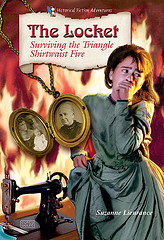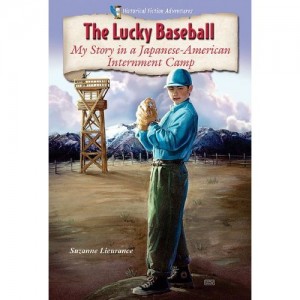 Galena, an eleven-year-old Russian-Jewish immigrant, lives in New York City with her family and works at
Galena, an eleven-year-old Russian-Jewish immigrant, lives in New York City with her family and works at
the Triangle Shirtwaist Company factory with her older sister Anya. The factory pays low wages and has
terrible working conditions, making Anya yearn to join a union. Soon a horrible fire guts the factory leaving Galena with painful, horrific memories. Follow author Suzanne Lieurance in this dramatic historical fiction novel, as she describes how Galena uses the support of friends, family, and Jewish traditions to inspire her to fight for workers’ rights.
Age Range: 10 and up
Series: Historical Fiction Adventures
Paperback: 160 pages
Publisher: Enslow Publishers (July 1, 2012)
Language: English
ISBN-10: 1598453858
ISBN-13: 978-1598453850
Koji Miyamoto, 13, his American mom and Japanese dad have been living a quiet life in San Francisco. But when the Japanese attack Pearl Harbor on December 7, 1941 all that changes immediately. Koji secretly fears his father may have been part of the attack since he was in Japan when it happened taking care of his sick father. At school, he is picked on by a group of bullies, the trolley operator won't let him on the board and the government has taken away the family radio, insinuating that all Japanese are spies.
Finally, Koji's mom receives a letter saying that he is to be sent to a "relocation camp" which is nothing more than the Alameda Downs, a former racetrack. His mother decides to go with him, but because she is white, not Japanese, she and the camp commander become friends. Koji, who is called Gaijin (outsider) by the other Japanese boys finds himself getting bullied by them. After getting caught fighting, an elderly old family friend man, Yoshi Asai, takes Koji under his wing. But after the two create a Victory Garden, the bullies go after it night after night.
Koji finds himself getting more and more angry as the days go by, at the government for putting them in horse stables and then treating them like they are all criminals; at the bullies for making him feel like he doesn't belong anywhere. Pretty soon a rift develops between Koji and his mom, fueled by the bullies repeatedly calling her the camp floozy.
The bullies set up all kinds of dangerous tasks for Koji to do with the promise of belonging as his reward. As the tasks get riskier, Koji faces the possibility of being sent to a very unpleasant correction facility alone. Is his desire to belong or his anger so great that his is willing to risk that fate? Or can the gentle elderly Mr. Yoshi Asai help keep Koji from getting into more trouble?
Gaijin: American Prisoner of War is based on a true story from author/illustrator Matt Faulkner's family, as he explains at the end of the story, making it personal and affecting. Using the graphic novel format, allows the reader to see the anger, confusion, fear, all the understandable feelings of a young man forced to live the way the Miyamoto's were, and being treated like an enemy alien because of his race, not his citizenship.
The illustrations are done using watercolor and gouache in rich vibrant colors very reminiscent of the early 1940s. Gouache is the perfect medium for this graphic novel, with its large bold energetic images, sometimes only one to a pages, other times as many as five. Much of the story comes through the illustrations, with little text but together they really capture every humiliating element of the internment of the Japanese in WWII.
The more I read graphic novels, the more I appreciate them. When they are done well, as
Gaijin is, they can be a way of introducing difficult topics to young readers and may serve as a way to interest reluctant readers.
Another excellent book about this still not widely known about part of American history.
This book is recommended for readers age 9+
This book was bought for my personal library

 Harry Yakamoto lives with his father and grandparents above the restaurant they operate in Seven Cedars, CA. His prized possession is a signed baseball from Joe DiMaggio. As Japanese-Americans in the early 1940s, Harry and his family often face discrimination, but things get worse after the attack on Pearl Harbor. The Yakamotos are forced to relocate to the Manzanar Internment Camp, where they live in close quarters, eat meals in a mess hall, and share a communal bathroom. Determined to make the best of the situation, Harry organizes a baseball team and improves his pitching, thanks to a kindly guard who gives him some pointers. The setting is brought to life with vivid descriptions of life in 1940s America and in the internment camp. Baseball is woven seamlessly throughout the story and will appeal to sports fans.
Harry Yakamoto lives with his father and grandparents above the restaurant they operate in Seven Cedars, CA. His prized possession is a signed baseball from Joe DiMaggio. As Japanese-Americans in the early 1940s, Harry and his family often face discrimination, but things get worse after the attack on Pearl Harbor. The Yakamotos are forced to relocate to the Manzanar Internment Camp, where they live in close quarters, eat meals in a mess hall, and share a communal bathroom. Determined to make the best of the situation, Harry organizes a baseball team and improves his pitching, thanks to a kindly guard who gives him some pointers. The setting is brought to life with vivid descriptions of life in 1940s America and in the internment camp. Baseball is woven seamlessly throughout the story and will appeal to sports fans.
Kristen Oravec, Flint Hill Middle School, Oakton, VA
Age Range: 10 and up
Grade Level: 5 and up
Series: Historical Fiction Adventures
Paperback: 160 pages
Publisher: Enslow Publishers
Language: English
ISBN-10: 0766036553
ISBN-13: 978-0766036550
 Author: Maxine Trottier (on JOMB)
Author: Maxine Trottier (on JOMB)
Illustrator: Paul Morin (on JOMB)
Published: 1999 Fitzhenry and Whiteside (on JOMB)
ISBN: 1550051520
Chapters.ca Amazon.com
Dazzling light glows against darkening shadow as this warmly told memory of friendship and fortitude peeks into a dim chapter in Canadian history.
Other books mentioned:
For more information about the Japanese Internment of 1942-1945, visit Vanishing British Columbia, Canada: A People’s History, and Canadian Nikkei.
You can read about more of our favourite Canadian, Asian-themed children’s books in this essay by Andrea at Paper Tigers.
We’d love to hear your thoughts on a favourite children’s book. Leave a voice message on our JOMB listener hotline, +1-206-350-6487.
I thought looking at the Hirabayashi v. United States case might serve as a strong reminder of the questionable decisions the United States has historically made during times of war. The Hirabayshi case, which you can learn about below, was overturned in 1987. This excerpt was found using Oxford Reference Online and originally appeared in The Oxford Guide to United States Supreme Court Decisions.
Hirabayashi v. United States, 320 U.S. 81 (1943), argued 10 and 11 May 1943, decided 21 June 1943 by vote of 9 to 0; Stone for the Court, Douglas and Murphy concurring in separate opinions with the result; Rutledge concurring in a separate opinion with the Court’s opinion. (more…)
Share This
 Galena, an eleven-year-old Russian-Jewish immigrant, lives in New York City with her family and works at
Galena, an eleven-year-old Russian-Jewish immigrant, lives in New York City with her family and works at




 Author:
Author: